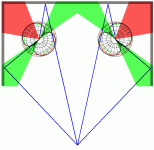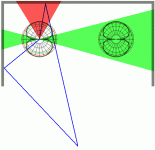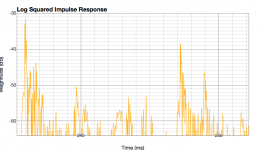I don't believe in box colorations either. Every speaker has it's flaws in it's performance and peaks in response (direct or power) are heard easily. Many speakers also have cone breakup problems. Perhaps most Ob speakers have paper (or soft) cones and thus less peaks in response?
I don't have much experience with dipoles but they are not overall better per se, different sounding yes. Good boxed speakers sound extremely good, you could say flawless. Still there is a difference to a dipole. Speaker's effect/behaviour on/with room reflections and modes is the reason for this (as to my understanding). Which is better depends on your taste, room and to some extent on which type of music you are reproducing with them
I don't have much experience with dipoles but they are not overall better per se, different sounding yes. Good boxed speakers sound extremely good, you could say flawless. Still there is a difference to a dipole. Speaker's effect/behaviour on/with room reflections and modes is the reason for this (as to my understanding). Which is better depends on your taste, room and to some extent on which type of music you are reproducing with them
Last edited:
Many, perhaps most, are.box coloration is a fallacy unless the box is junk.
I hear it in most boxes. In well constructed boxes, no.It can't be measured, I've tried, and I don't hear it.
I hear it in most boxes.
How do you know that? Oh yea hearing infallibility, I forgot
mmmmmm Batman's Library
I'm experimenting with a similar set up JimBones.
I think it depends on how close the baffles are to the rear wall(s) and how reflective the behind speaker wall is.
In a modest room, I would definitely experiment with absorbers behind the speakers. Directly behind speakers, but also in the rear centre, in line with your 'sweet spot' if possible.
You can dampen some of the ambience, the liveness with rear absorbers/diffusors. Helps to focus/define the soundstage.
I've built some prototype, quickie test OB's. Probably are a bit too big for my space. The further from the walls I move them the better they sound. I end wanting to put them right, smack bang in the middle of the living room. No WAF.
IMO: OB's really need (will work best in) a nice big, spacious room with lots of books shelves, heavy curtains, persian rugs but also some wood panelling/diffusors way behind speakers; for the just right amount of reflective ambience.....Batman's library or small Gothic cathedral would be perfect. mmmmmmm batman's library
I'm experimenting with a similar set up JimBones.
I think making the area behind the speaker absorbtive goes against the idea of an OB speaker. Suggestions appreciated.
I think it depends on how close the baffles are to the rear wall(s) and how reflective the behind speaker wall is.
In a modest room, I would definitely experiment with absorbers behind the speakers. Directly behind speakers, but also in the rear centre, in line with your 'sweet spot' if possible.
You can dampen some of the ambience, the liveness with rear absorbers/diffusors. Helps to focus/define the soundstage.
I've built some prototype, quickie test OB's. Probably are a bit too big for my space. The further from the walls I move them the better they sound. I end wanting to put them right, smack bang in the middle of the living room. No WAF.
IMO: OB's really need (will work best in) a nice big, spacious room with lots of books shelves, heavy curtains, persian rugs but also some wood panelling/diffusors way behind speakers; for the just right amount of reflective ambience.....Batman's library or small Gothic cathedral would be perfect. mmmmmmm batman's library
I don't believe in box colorations either.
what's that in your avatar? open baffle dipole MTM? why? do I see MTM and midbass on dipole too? you should reconsider your latest built Juhazi then...if you do not believe in box coloration
(btw I do not believe it either, I hear it)
Last edited:
acoustics and OB's
Thanks Timbo, I should post a picture tomorrow of the room. my room right now sounds kind of dead. I have acoustic 2x2 ceiling tile mixed with Auralex diffusors and carpeted floor.
I'm experimenting with a similar set up JimBones.
I think it depends on how close the baffles are to the rear wall(s) and how reflective the behind speaker wall is.
In a modest room, I would definitely experiment with absorbers behind the speakers. Directly behind speakers, but also in the rear centre, in line with your 'sweet spot' if possible.
You can dampen some of the ambience, the liveness with rear absorbers/diffusors. Helps to focus/define the soundstage.
I've built some prototype, quickie test OB's. Probably are a bit too big for my space. The further from the walls I move them the better they sound. I end wanting to put them right, smack bang in the middle of the living room. No WAF.
IMO: OB's really need (will work best in) a nice big, spacious room with lots of books shelves, heavy curtains, persian rugs but also some wood panelling/diffusors way behind speakers; for the just right amount of reflective ambience.....Batman's library or small Gothic cathedral would be perfect. mmmmmmm batman's library
Thanks Timbo, I should post a picture tomorrow of the room. my room right now sounds kind of dead. I have acoustic 2x2 ceiling tile mixed with Auralex diffusors and carpeted floor.
Because I know what boxes sound like. Nothing unusual there. If you don't, that's nothing to do with me.How do you know that?
Just because there are people who don't (or can't) see jpeg artifacts in photos, or mpeg artifacts in video, or color balance flaws, or metamerism in prints, or aspect ratio errors, that does not mean these things don't exist and can't be perceived. Audio is similar. E.G., going from a demo in the Magnapan room to a demo in the Harbeth room was quite surprising.
I do not suffer from this. Do you?Oh yea hearing infallibility, I forgot
Because I know what boxes sound like. Nothing unusual there. If you don't, that's nothing to do with me.
Just because there are people who don't (or can't) see jpeg artifacts in photos, or mpeg artifacts in video, or color balance flaws, or metamerism in prints, or aspect ratio errors, that does not mean these things don't exist and can't be perceived. Audio is similar. E.G., going from a demo in the Magnapan room to a demo in the Harbeth room was quite surprising.
I do not suffer from this. Do you?
Pano, I can see where the doc is coming from. I know you have "good" ears, i.e, trained ears that can detect resonances and artifacts. But that doesn't mean I do as well, although I can claim whatever I want and say that my opinion is as valid as yours or anyone else's. That's where the problem is. There is no way we can rely on an expert's opinion
If you both read each other's post about OB v box sound, you essentially said the same thing
adason, my latest project Aino gradient has dipole function from 300 to 3200Hz (xo frequencies). It is my first dipole construction. I have listened to several other dipoles but not at home. I don't think that I could have made a decent dipole without minidsp.
My boxed speakers have mostly 25mm mdf heavily studded and also stuffed cabinets. Box coloration may come from vibrating walls and internal modes. Also baffle diffractions colorize sound. Internal (back)waves are impossible to me to measure - I can see peaks and dips in response but I don't know the reason for all of them. Dipoles have edge diffractions too, they are no way free of disturbancies or flaws. Dipoles are much more difficult to design, I think.
S Linkwitz, J Kreskowky and R Finke have excellent reading for dipole/OB designers at their homepages!
My boxed speakers have mostly 25mm mdf heavily studded and also stuffed cabinets. Box coloration may come from vibrating walls and internal modes. Also baffle diffractions colorize sound. Internal (back)waves are impossible to me to measure - I can see peaks and dips in response but I don't know the reason for all of them. Dipoles have edge diffractions too, they are no way free of disturbancies or flaws. Dipoles are much more difficult to design, I think.
S Linkwitz, J Kreskowky and R Finke have excellent reading for dipole/OB designers at their homepages!
The server had it's maintenace pause, I want to add that
The different sound of a dipole is due to different radiation pattern of sound waves. The main reason for this is the box that blocks the rear wave radiation of a driver's membrane. Other ways to block rear wave can be seen in a compression driver+horn, closed frame of a tweeter etc. It is not wise to call all this "box coloration"
The radiation pattern is different at different frequencies, and this can be calculated (simulation programs do that) but the real speaker's overall radiation pattern never follows simulations, because no speaker drivers are perfect dipoles and they are set in some kind of frame or near reflective/diffractive surfaces .
The different sound of a dipole is due to different radiation pattern of sound waves. The main reason for this is the box that blocks the rear wave radiation of a driver's membrane. Other ways to block rear wave can be seen in a compression driver+horn, closed frame of a tweeter etc. It is not wise to call all this "box coloration"
The radiation pattern is different at different frequencies, and this can be calculated (simulation programs do that) but the real speaker's overall radiation pattern never follows simulations, because no speaker drivers are perfect dipoles and they are set in some kind of frame or near reflective/diffractive surfaces .
We haven't done our homework with dipoles until we have considered their special directivity pattern wrt first wall reflections. In this picture I show the 'loud' part of a dipole in red and the 'silent' part in green. 'Silent' means at least 10 dB down at the source. Blue lines are the first reflections from the front and side walls.

We notice how the first side wall reflection is very much attenuated, and it is very silent behind the center phantom image too. We need to do something about the first reflection from the front wall - but only in that area.
There will be strong reflections from the room corners (no lines shown in the picture), but they have to travel over two walls. That makes them a bit more diffuse than the front wall reflection. We will get a marvellous 'cinemascope' sound, if we leave the corners untreated, but it is not natural/realistic of course. So it is advisable to put something diffusive/absorptive into those corners.
You will have noticed that the speakers are toed-in 45°. Listening angle is ~30°. What will happen, if we align the dipoles parallel to the side walls:

We see how this alignment doesn't make any good use of the dipole 'nulls' and how it puts the front wall reflection into the hottest part of the radiation pattern.
The pictures don't include the first contralateral reflections. But you can imagine them easily. With toe-in they will be quite strong and contain the full frequency spectrum. They nicely support the feeling of spaciousness.
Rudolf

We notice how the first side wall reflection is very much attenuated, and it is very silent behind the center phantom image too. We need to do something about the first reflection from the front wall - but only in that area.
There will be strong reflections from the room corners (no lines shown in the picture), but they have to travel over two walls. That makes them a bit more diffuse than the front wall reflection. We will get a marvellous 'cinemascope' sound, if we leave the corners untreated, but it is not natural/realistic of course. So it is advisable to put something diffusive/absorptive into those corners.
You will have noticed that the speakers are toed-in 45°. Listening angle is ~30°. What will happen, if we align the dipoles parallel to the side walls:

We see how this alignment doesn't make any good use of the dipole 'nulls' and how it puts the front wall reflection into the hottest part of the radiation pattern.
The pictures don't include the first contralateral reflections. But you can imagine them easily. With toe-in they will be quite strong and contain the full frequency spectrum. They nicely support the feeling of spaciousness.
Rudolf
With toe-in they will be quite strong and contain the full frequency spectrum. They nicely support the feeling of spaciousness.
Rudolf
Markus would claim this to be a strong negative feature.
Markus would claim this to be a strong negative feature.
No. You obviously missed some of my invaluable posts
minidsp
My next design will most likely be minidsp. Others have recommended it and I have 2 big power amps. Now I know who to ask when time rolls around
adason, my latest project Aino gradient has dipole function from 300 to 3200Hz (xo frequencies). It is my first dipole construction. I have listened to several other dipoles but not at home. I don't think that I could have made a decent dipole without minidsp.
My boxed speakers have mostly 25mm mdf heavily studded and also stuffed cabinets. Box coloration may come from vibrating walls and internal modes. Also baffle diffractions colorize sound. Internal (back)waves are impossible to me to measure - I can see peaks and dips in response but I don't know the reason for all of them. Dipoles have edge diffractions too, they are no way free of disturbancies or flaws. Dipoles are much more difficult to design, I think.
S Linkwitz, J Kreskowky and R Finke have excellent reading for dipole/OB designers at their homepages!
My next design will most likely be minidsp. Others have recommended it and I have 2 big power amps. Now I know who to ask when time rolls around
No. You obviously missed some of my invaluable posts
That's certainly not the way I remember your position.
I always viewed the contra-lateral reflection as positive if it was delayed long enough - the delay time being the critical aspect.
I always viewed the contra-lateral reflection as positive if it was delayed long enough - the delay time being the critical aspect.
I don't think it's that simpel. I believe that level and spectrum is also a significant factor and all those parameters (including incidence angle) are tightly linked to each other.
Left speaker and the two contralateral reflections after about 11ms and 13ms:
Hope you post similar data from your room some day.
Attachments
By definition IAAC doesn't know about left and right - it only values difference.
In a highly symmetric stereo situation with large driver toe-in the pair of contra-lateral first reflections is very much like the pair of direct sounds - just later and mirrored. If our brain can detect the "mirror"-effect easily, then the contra-lateral reflection shoud be a strong supporter for the brain to get a clearer 'view' of the spatial scene.
Just a proposal for understanding ...
Rudolf
In a highly symmetric stereo situation with large driver toe-in the pair of contra-lateral first reflections is very much like the pair of direct sounds - just later and mirrored. If our brain can detect the "mirror"-effect easily, then the contra-lateral reflection shoud be a strong supporter for the brain to get a clearer 'view' of the spatial scene.
Just a proposal for understanding ...
Rudolf
From my perspective "box coloration" includes resonances and internal reflections (that end up as external sound) that are both audible and measurable in LOTS of speakers, but I do tend to dabble in "junk".  No avoidable design flaw can be a very good point against having a rear enclosure.
No avoidable design flaw can be a very good point against having a rear enclosure.
- Status
- This old topic is closed. If you want to reopen this topic, contact a moderator using the "Report Post" button.
- Home
- General Interest
- Room Acoustics & Mods
- OB speakers and room acoustics
